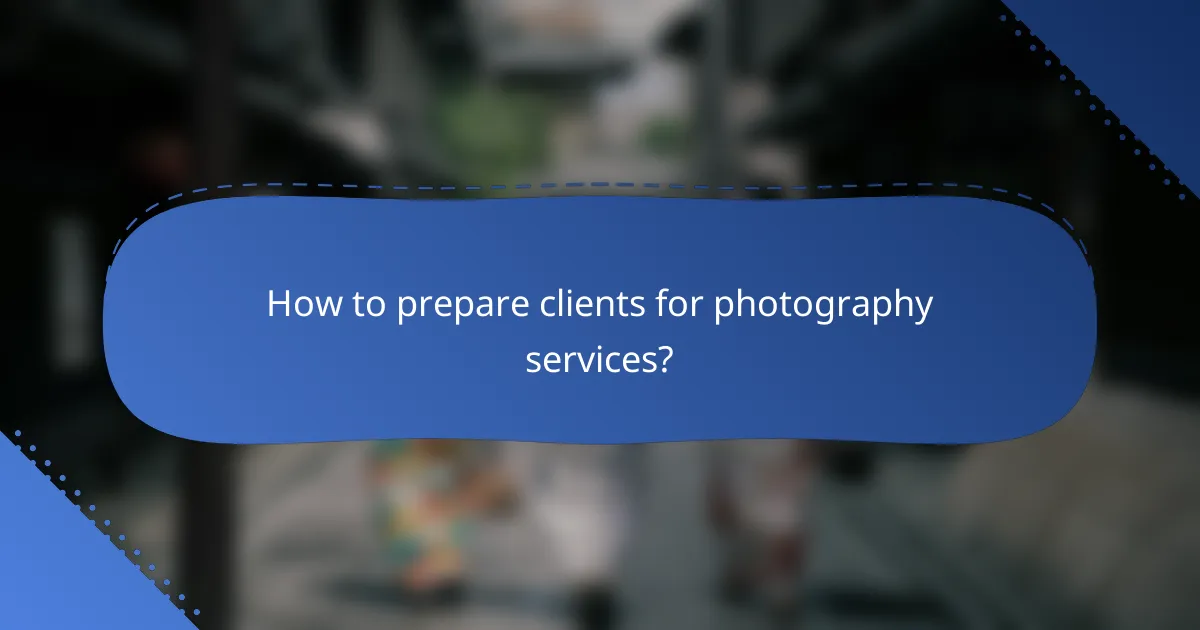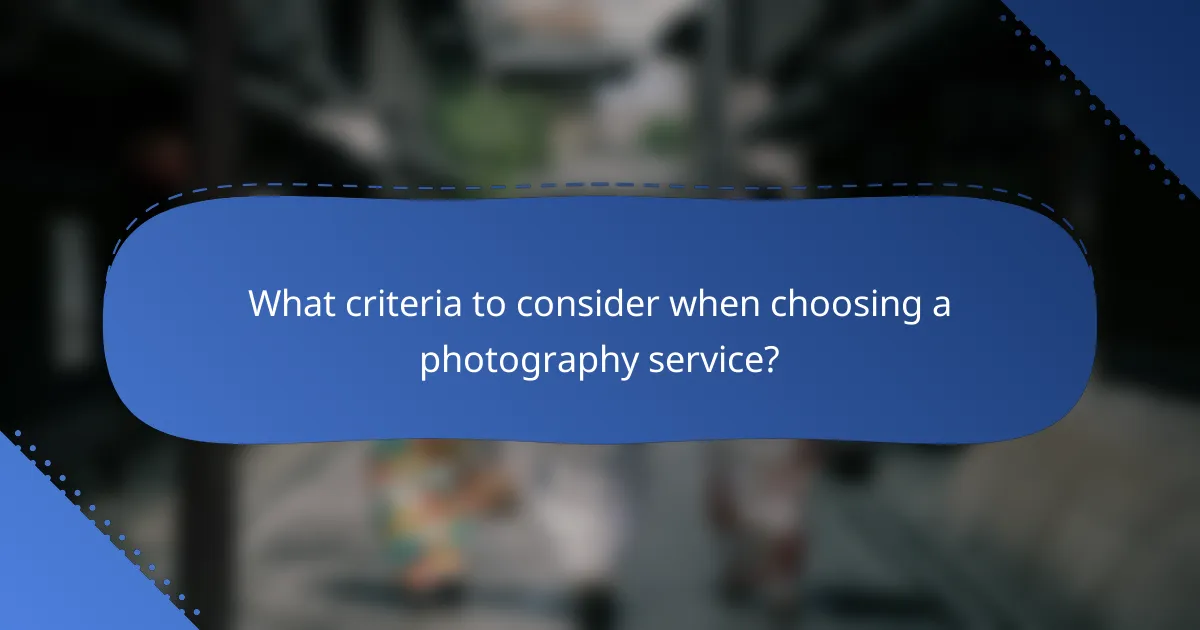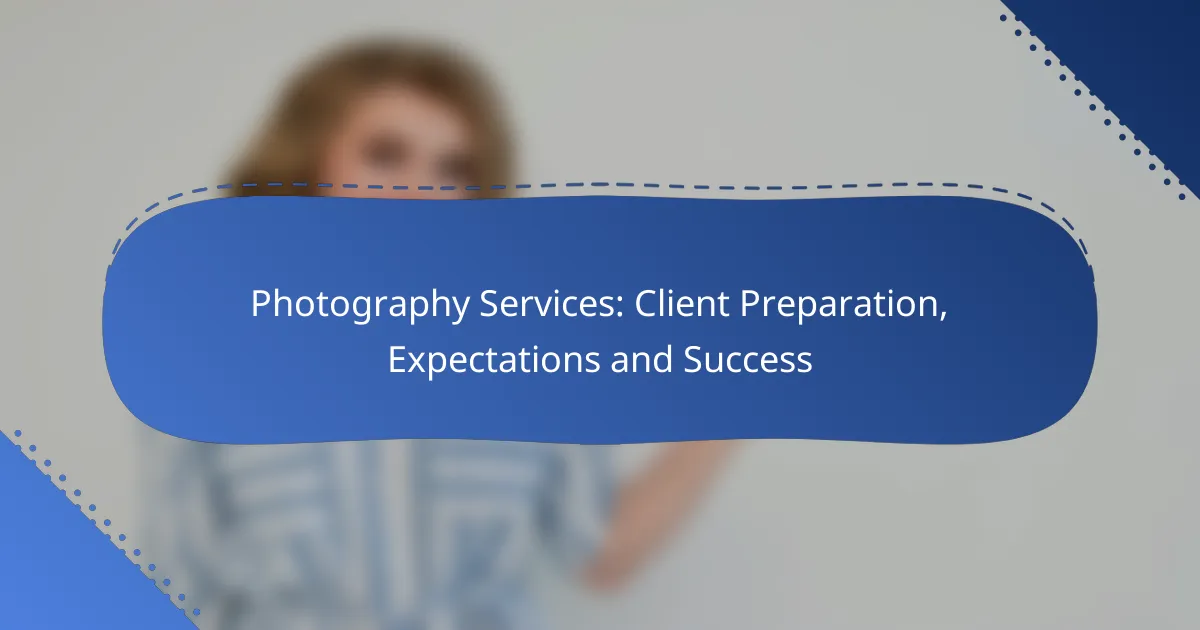Preparing clients for photography services is essential for achieving satisfactory results and a smooth experience. Clear communication about needs and expectations allows for a structured yet flexible session, where comfort and guidance play crucial roles. By focusing on effective planning and open dialogue, both clients and photographers can work together to create memorable images.

How to prepare clients for photography services?
Preparing clients for photography services involves clear communication and understanding their needs. This ensures a smooth process and satisfactory results for both the photographer and the client.
Initial consultation
The initial consultation is crucial for establishing rapport and understanding the client’s needs. During this meeting, discuss the client’s vision, preferences, and any specific requirements they may have for the shoot.
Consider using this time to explain your photography style and approach, which helps align expectations. A successful consultation sets the foundation for a productive relationship.
Understanding client vision
Understanding the client’s vision is essential for delivering results that meet their expectations. Ask open-ended questions to encourage clients to share their ideas, inspirations, and any reference images they may have.
Encourage clients to articulate the emotions or themes they want to capture, as this will guide your creative decisions during the shoot. Take notes to ensure you remember their preferences and can refer back to them later.
Discussing logistics
Logistics play a vital role in the success of a photography session. Discuss details such as the location, date, time, and duration of the shoot, as well as any necessary permits or permissions required for specific venues.
Additionally, clarify the number of people involved, wardrobe changes, and any props or equipment needed. This thorough planning helps avoid last-minute surprises and ensures a smooth experience.
Setting expectations
Setting clear expectations helps prevent misunderstandings and ensures client satisfaction. Discuss what clients can expect in terms of deliverables, including the number of edited images, turnaround time, and any additional services offered.
Be transparent about your process, including how you handle rescheduling or cancellations. This clarity fosters trust and prepares clients for the overall experience.
Creating a mood board
A mood board is a visual tool that helps convey the desired style and atmosphere of the shoot. Encourage clients to gather images, colors, and themes that resonate with their vision, which can guide your creative direction.
Use platforms like Pinterest or physical collages to compile these elements. A well-prepared mood board not only aligns your vision with the client’s but also serves as a reference point during the shoot, ensuring everyone is on the same page.

What should clients expect during a photography session?
Clients can expect a structured yet flexible experience during a photography session, where the photographer will guide them through various stages to capture the desired images. Preparation, communication, and comfort are key to ensuring a successful outcome.
Timeline of the session
The timeline of a photography session can vary based on the type of shoot, but most sessions last between one to three hours. It’s important to discuss the schedule in advance, including setup time, breaks, and the estimated duration for different locations or setups.
Clients should arrive on time and be prepared for any potential delays, as factors like weather or lighting conditions can influence the session’s flow. A well-planned timeline helps maximize the number of shots taken and ensures a smooth experience.
Types of shots planned
Before the session, clients should discuss the types of shots they want, whether they are candid moments, posed portraits, or specific themes. This helps the photographer understand the client’s vision and plan accordingly.
Common shot types include close-ups, wide angles, and action shots. Providing examples or references can help clarify expectations and ensure the photographer captures the desired style and mood.
Interacting with the photographer
Effective communication with the photographer is essential for a successful session. Clients should feel comfortable expressing their preferences, asking questions, and providing feedback throughout the shoot.
Photographers often appreciate when clients share their ideas and concerns, as this collaboration can lead to more authentic and engaging images. Establishing rapport can also help ease any nerves and create a more relaxed atmosphere.
Comfort and posing guidance
Comfort is crucial during a photography session, as it directly impacts the quality of the images. Clients should wear outfits that make them feel confident and at ease, and they can discuss any specific concerns with the photographer beforehand.
Photographers typically provide posing guidance to help clients achieve flattering angles and natural expressions. Simple tips, like shifting weight from one foot to another or using hands to create shapes, can enhance the overall look of the photos.

How to ensure success in photography projects?
Success in photography projects hinges on effective planning, communication, and follow-up. By establishing clear expectations and maintaining open dialogue, clients and photographers can achieve desired outcomes and memorable results.
Clear communication
Clear communication is vital for the success of any photography project. Clients should articulate their vision, preferences, and any specific requirements they have in mind. Photographers, in turn, must provide feedback and suggestions to align with the client’s expectations.
Regular check-ins throughout the project can help clarify any misunderstandings and ensure that both parties are on the same page. Using visual references, such as mood boards or sample images, can enhance understanding and set a clear direction.
Setting realistic goals
Setting realistic goals is essential to avoid disappointment. Clients should consider factors like budget, time constraints, and the scope of the project when defining their objectives. Photographers can assist by providing insights into what is achievable within the given parameters.
For instance, if a client desires a complex shoot but has a limited budget, discussing alternatives or simplifying the concept can lead to a more successful outcome. Establishing clear timelines and deliverables also helps manage expectations effectively.
Reviewing previous work
Reviewing previous work is a crucial step in selecting a photographer and understanding their style. Clients should examine portfolios to ensure the photographer’s aesthetic aligns with their vision. This can help in making informed decisions and setting expectations for the project.
Additionally, discussing past projects with the photographer can provide insights into their process and how they handle challenges. This exchange can foster trust and confidence, leading to a more collaborative working relationship.
Post-session follow-up
A post-session follow-up is important for ensuring satisfaction and addressing any concerns. Clients should take the time to review the delivered images and provide feedback to the photographer. This not only helps in resolving any issues but also strengthens the relationship for future projects.
Photographers can benefit from this feedback by understanding client preferences and improving their services. A simple thank-you note or a request for a review can also go a long way in maintaining a positive rapport and encouraging referrals.

What criteria to consider when choosing a photography service?
When selecting a photography service, consider the photographer’s style, experience, and client feedback. These factors will help ensure that the final images align with your vision and expectations.
Portfolio evaluation
Evaluating a photographer’s portfolio is crucial in determining if their style matches your needs. Look for a diverse range of work that showcases their skills in various settings, lighting conditions, and subjects. Pay attention to the quality of editing and consistency throughout their projects.
Consider requesting a portfolio that reflects similar projects to yours, whether it’s weddings, corporate events, or family portraits. This will give you a clearer idea of how they might handle your specific requirements.
Client testimonials
Client testimonials provide valuable insight into a photographer’s reliability and professionalism. Look for reviews on their website, social media pages, or third-party platforms to gauge overall satisfaction. Positive feedback often highlights aspects like communication, punctuality, and the quality of the final product.
Don’t hesitate to ask for references from past clients. Speaking directly with someone who has previously hired the photographer can offer a more personal perspective on their experience.
Pricing structures
Understanding pricing structures is essential when choosing a photography service. Photographers may offer packages that include different services, such as pre-shoot consultations, editing, and prints. Compare these packages to see what best fits your budget and needs.
Be aware of any additional costs that may arise, such as travel fees or extra hours of coverage. It’s advisable to clarify all potential expenses upfront to avoid surprises later on. A typical range for professional photography services can vary widely, often starting from a few hundred to several thousand dollars, depending on the complexity of the shoot and the photographer’s experience.

How do photography services differ across regions?
Photography services vary significantly across regions due to cultural influences, local styles, and market demands. Understanding these differences can help clients choose the right photographer and set appropriate expectations for their projects.
Local styles and trends
Local styles and trends in photography reflect the cultural heritage and aesthetic preferences of a region. For instance, in Europe, fine art and documentary styles may dominate, while in the United States, lifestyle and commercial photography often take precedence. Each region has its unique flair that can influence the final output.
Clients should research local photographers to understand their specialties and the prevalent styles in that area. For example, a wedding photographer in Italy might focus on romantic, soft lighting and historical backdrops, while a photographer in Japan may emphasize minimalism and nature integration.
To ensure alignment with local trends, consider reviewing portfolios and asking potential photographers about their approach to capturing regional characteristics. This can help avoid mismatched expectations and lead to more satisfying results.
